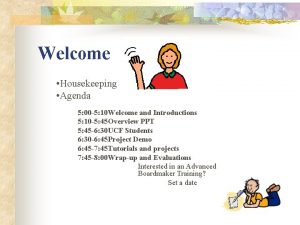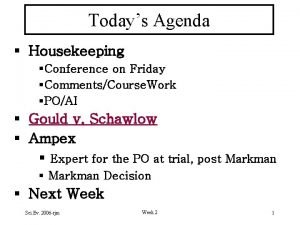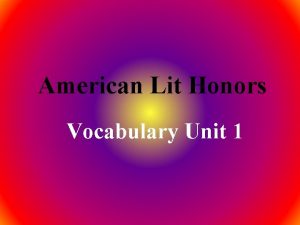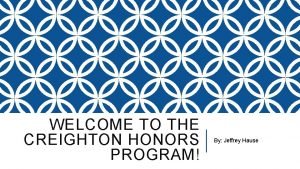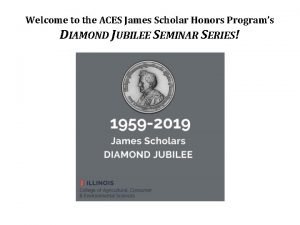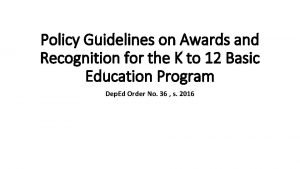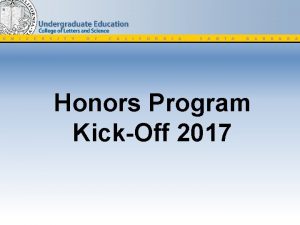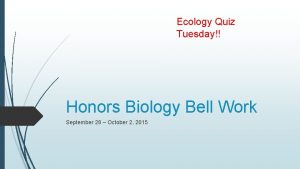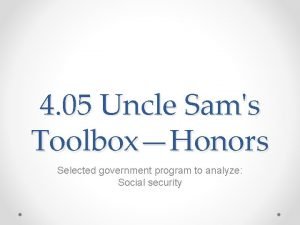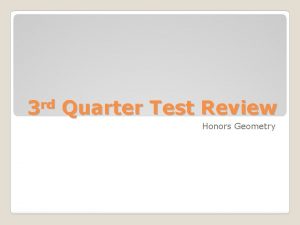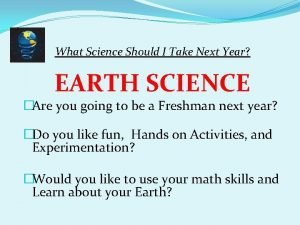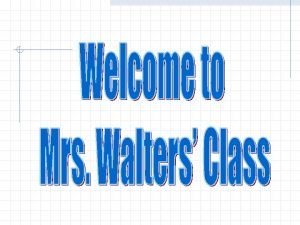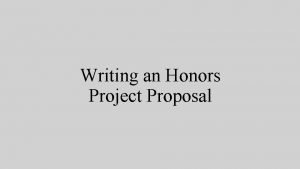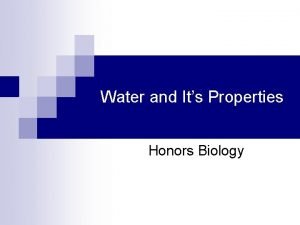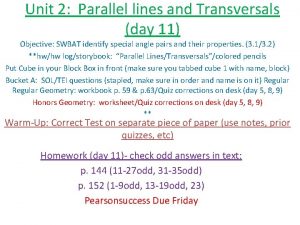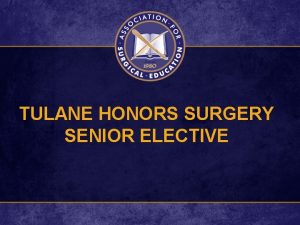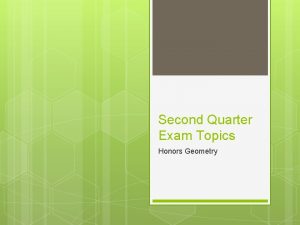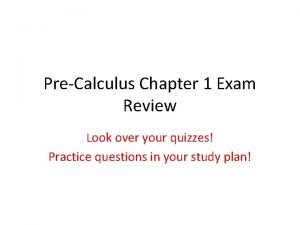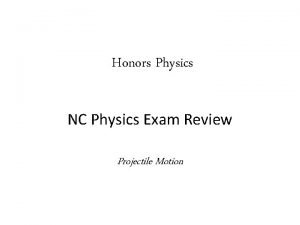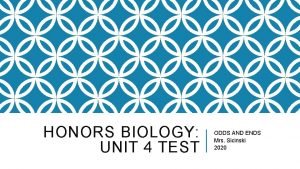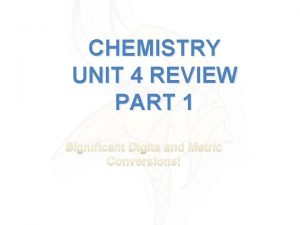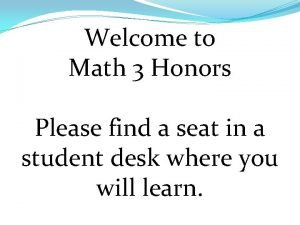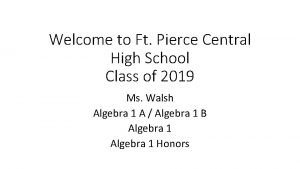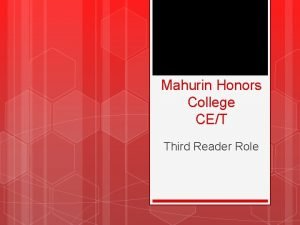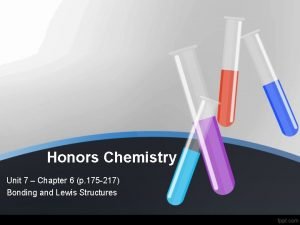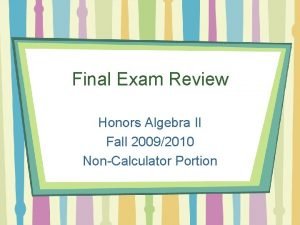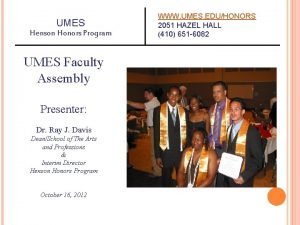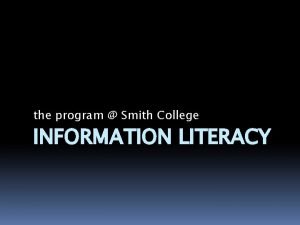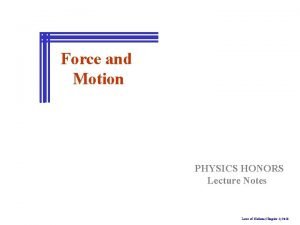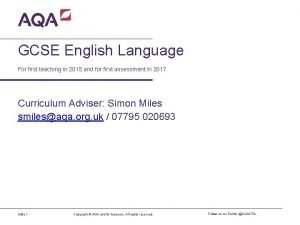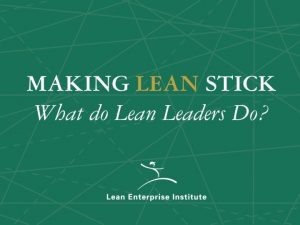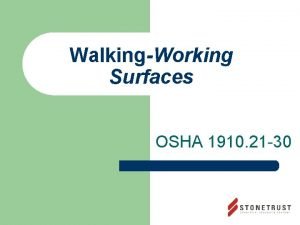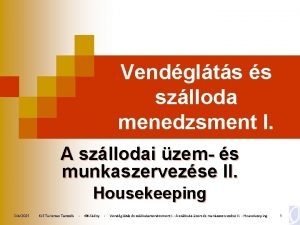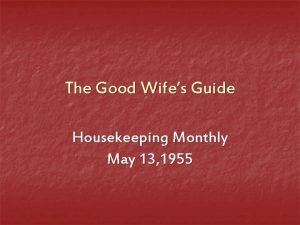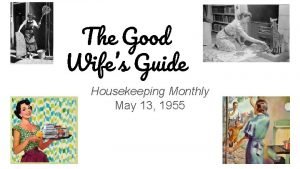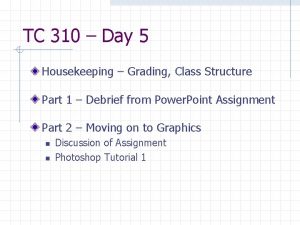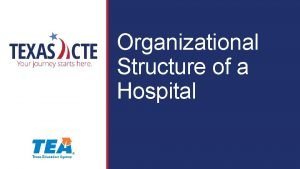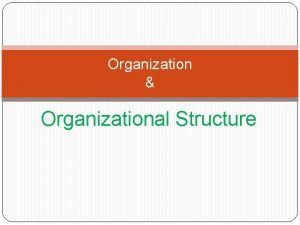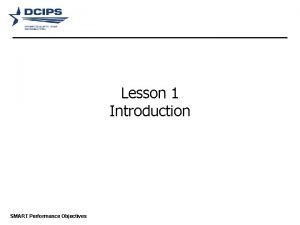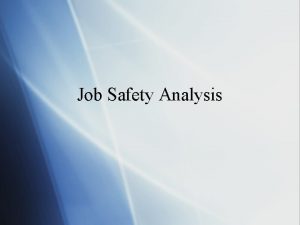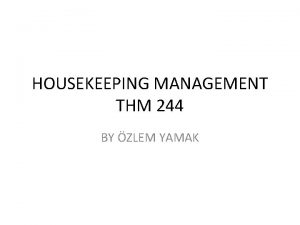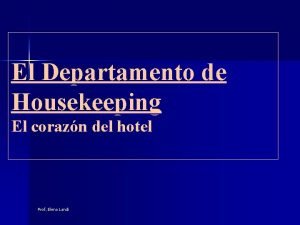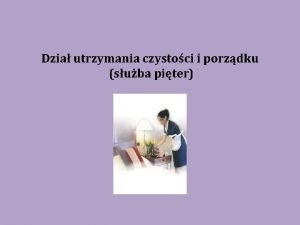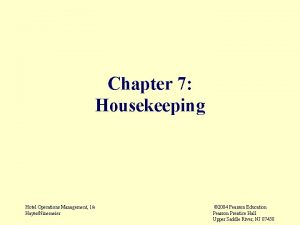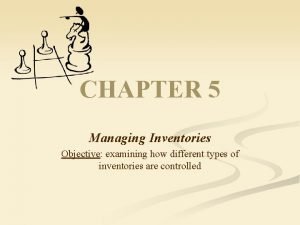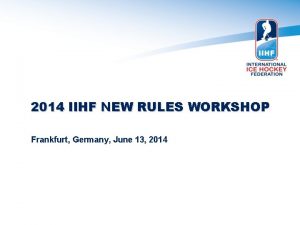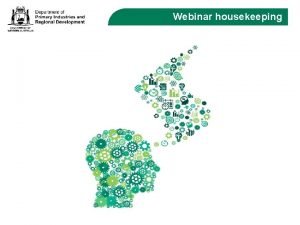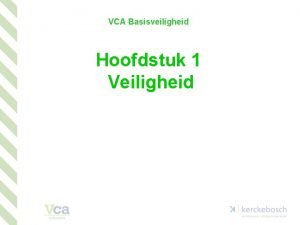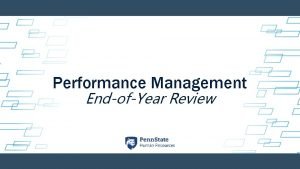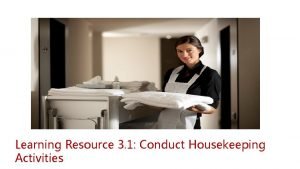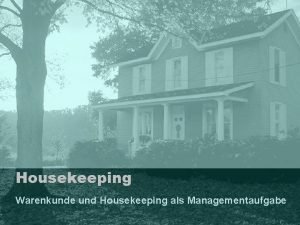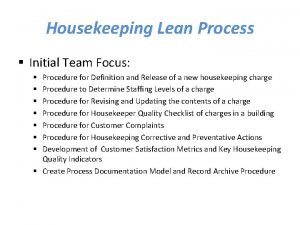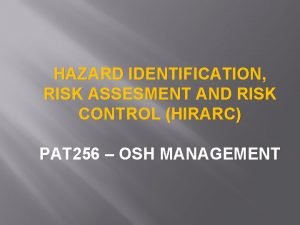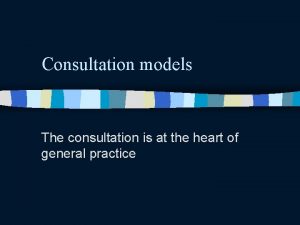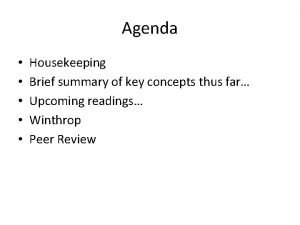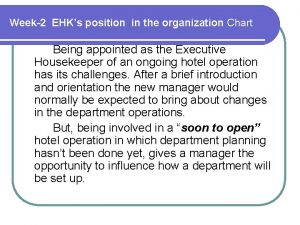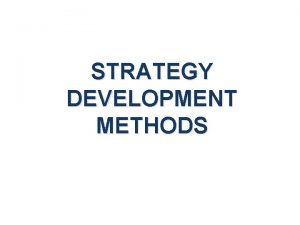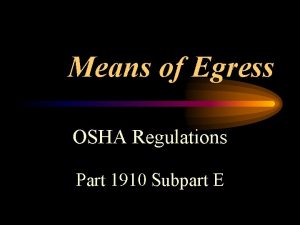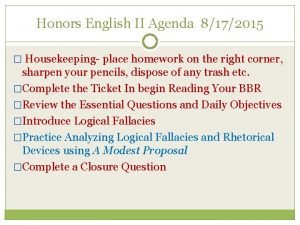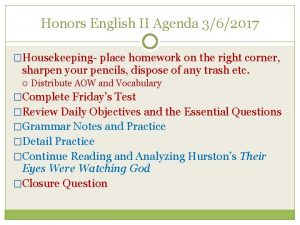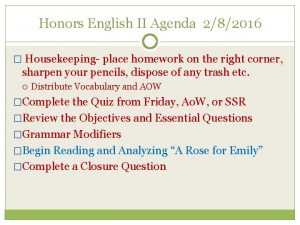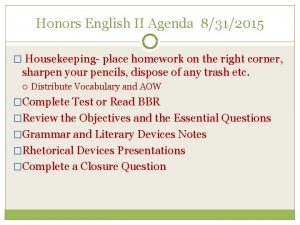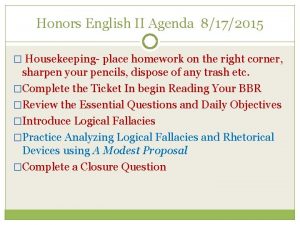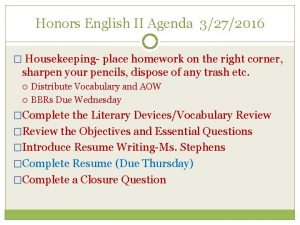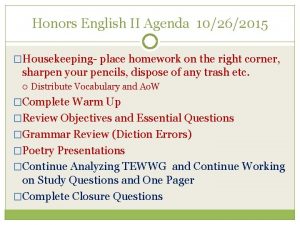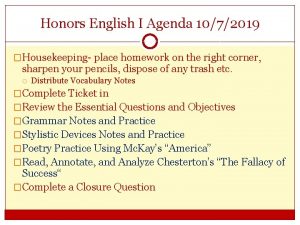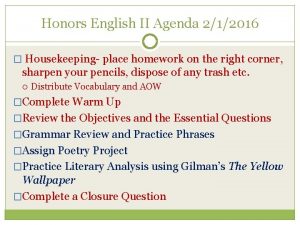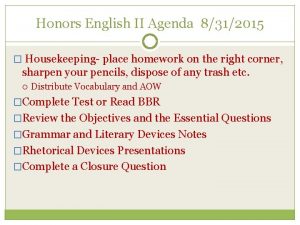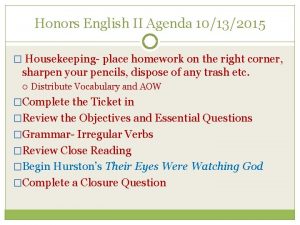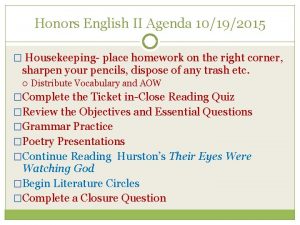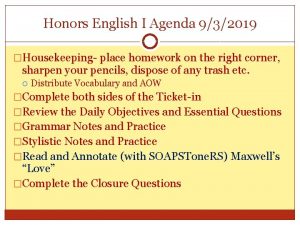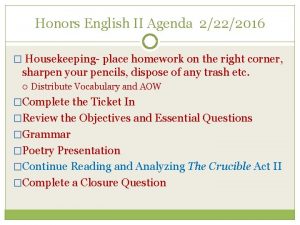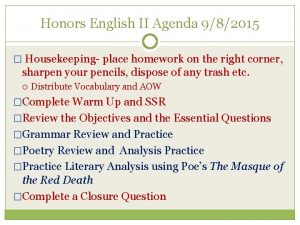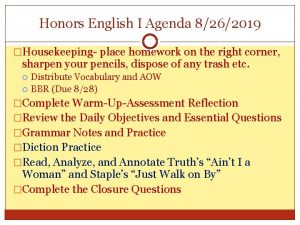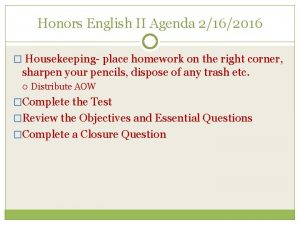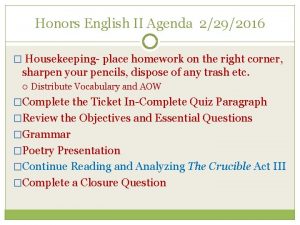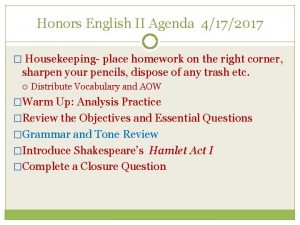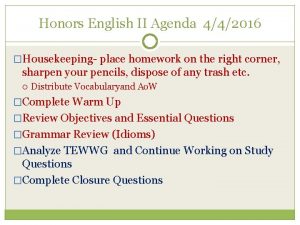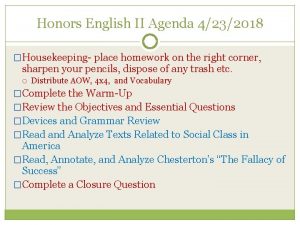Honors English II Agenda 1302017 Housekeeping place homework
















































































- Slides: 80

Honors English II Agenda 1/30/2017 �Housekeeping- place homework on the right corner, sharpen your pencils, dispose of any trash etc. Distribute AOW and Vocabulary Notes �Warm Up-Complete Friday’s Test �Review the Essential Questions and Daily Objectives �Grammar and Stylistic Devices Practice �Poetry Notes and Practice �Rhetorical Devices Project Presentations �Complete a Closure Question

Objectives � Read closely to determine what the text says explicitly and to make logical inferences from it; cite specific textual evidence when writing or speaking to support conclusions drawn from the text. � Determine central ideas or themes of a text and analyze their development; summarize the key supporting details and ideas. � Interpret words and phrases as they are used in a text, including determining technical, connotative, and figurative meanings, and analyze how specific word choices shape meaning or tone. � Analyze the structure of texts, including how specific sentences, paragraphs, and larger portions of the text relate to each other and the whole.

Essential Questions � How is a culture created? � How does the manipulation of language impact how people believe, think, feel, and react? � How do culture, propaganda, and the government influence how people believe, think, feel, and react? � Is it possible for thoughts or words to be illegal? � To what extent does popular culture determine what our society values? � Is it possible to protect oneself from the influence of media, government, and propaganda? Is it possible to be completely objective? � What are the basic tools used by an author to manipulate the audience? As readers, how do we identify and analyze these tools?

Parallel Structure Review �Good writers try to present a series of ideas in similar grammatical structures so the ideas will read smoothly. If one element in a series in not parallel with the others, the result may be jarring or confusing. �Parallelism involves presenting equal ideas in words, phrases, clauses, or sentences of similar types.

Parallel Structure Examples Parallel Words: The surfer looked strong, fit, and agile. Parallel Phrases: The greatest feeling I know is to ride a giant wave flawlessly and to have all my friends watch me enviously. Parallel Clauses: The surfboard that you recommended and that my brother wants is on sale. Parallel Sentences: It couldn’t be, of course. It could never, never be. �Faulty parallelism can involve words, phrases, and clauses in a series of comparisons.

Phrases �When one adjective or adverb cannot convey enough information, a phrase can contribute more detail to a sentence. �A phrase is a group of words that does NOT include a subject and verb and can NOT stand alone as a sentence. �There are several kinds of phrases, including prepositional phrases, adverbial phrase, adjectival phrase, appositive phrases, participial phrases, gerund phrases, and infinitive phrases.

Phrases �A prepositional phrase consists of a preposition and a noun or pronoun, called the object of the preposition. Example: over their heads, until dark, and after the baseball game. �An adjectival phrase is a prepositional phrase that modifies a noun or pronoun by telling what kind or which one. Ex: A picture of great beauty hung in the meeting hall, I gave the people on the trip a tour. �An adverbial phrase is a prepositional phrase that modifies a verb, an adjective, or an adverb by pointing out where, why, when, in what way, and to what extent. During the earthquake a creek disappeared , I was worried by the weather report.

Phrase Practice- Identify the prepositional phrase in the following sentences. Then, identify the phrase as adjectival or adverbial. 1. 2. 3. 4. 5. 6. I often play at the park on Post Street. (2) Rosa chose the dress with blue stripes. The plane flew over the airport. The ball rolled across the floor. The library across the road has been an asset. Germany is a country with many castles.

Revise the following sentences to correct any flaws in parallelism. The animals of the Amazon included anacondas, macaws, insects, and a toad. 2. Every table in the diner was set with a knife and fork, a cup and saucer, and a salt shaker and a pepper shaker. 3. I could not wait to buy a new dress, eat at the restaurant, and to attend the formal dance. 4. Most people prefer chocolate chip cookies to eating oatmeal raisin. 1.

Diction Practice “ Doc awakened very slowly and clumsily like a fat man getting out of a swimming pool. His mind broke the surface and fell back several times. ” - John Stienbeck, Cannery Row 1. What is the subject of the verb broke? What does this tell you about Doc’s ability to control his thinking at this point in the story? 2. To what does surface refer? 3. List three active verbs that could be used to complete the sentence below. Act out one of the verbs for the class, demonstrating the verb’s connotation. He _____ into the crowded auditorium.

Poetry Notes �Poetry is expression that is written in verse, often with some form of regular rhythm. The basis of poetic expression is heightened sense of perception or consciousness. A poem can look like prose, and prose can contain poetic elements.

Poetry Notes � Narrative poem- tells a story Epic Poem- a long poem written in the narrative mode with legendary main characters, heroic figures, and adventurous plot, and an expansive setting � Lyric Poem- expresses feelings or ideas in a meter and rhyme that could be sung. Elegy- a lament over the death of someone or the loss of something Ode- a complex, serious, long lyric poem. Odes are very unified with just one theme handled in an extremely dignified manner with formal diction. The purpose of many odes is to eulogize someone or something. Ballad- narrative songs that may be sung or simply recited. The subjects are usually courage or love. They sometimes contain repetition of words or phrases for effect (a refrain), and consist of four-line stanzas in the abcb defe rhyme scheme. � Concrete poetry- concrete poems are highly graphic, modern poems that are also graphic art. � Sonnet: Sonnets are poems with 14 lines, usually with 10 syllables in each line, following the traditional English rhythm of unstressed and stressed beats called iambic pentameter.

Poetry Notes �Rhythm-in poetry is a variation of stressed and unstressed sounds that has some type of regular pattern, with grouping of the sounds into units. �Stanza- consists of lines that are grouped together in a poem because of the rhythm, rhyme scheme, and/or meaning �Enjambment-In poetry it means moving over from one line to another without a terminating punctuation mark. It can be defined as a thought or sense, phrase or clause in a line of poetry that does not come to an end at the line break but moves over to the next line. The holy time is quiet as a Nun Breathless with adoration; the broad sun Is sinking down in its tranquility;

Poetry Notes � Chiasmus-a rhetorical device in which two or more clauses are balanced against each other by the reversal of their structures in order to produce an artistic effect. A simple chiasmus can be broken into parts labeled ABBA Oh she will, will she All for one, and one for all. � Apostrophe-used in literature is an arrangement of words addressing a non-existent person, an abstract idea, or thing in such a way as if it were present and capable of understanding feelings. Ex: “Twinkle, twinkle little star, how I wonder what you are…” � Conceit-an extended metaphor that compares two very dissimilar things. In a sense we’ve come to our nation’s capital to cash a check…. It is obvious today that America has defaulted on this promissory note, insofar as her citizens of color are concerned. Instead of honoring this sacred obligation, America has given the Negro people a bad check, a check which has come back marked “insufficient funds.

Poetry Notes �Onomatopoeia- which is the use of a word that resembles the sound it denotes: quack, buzz, rattle, bang, squeak, bow wow, burp, ding a ling, etc. �Alliteration- is the repetition of the same consonant sounds at the beginning of nearby words: “descending dew drops, ” “luscious lemons” �Assonance- is the repetition of the same vowel sound in nearby words: “asleep under a tree”, “time and tide, ” “each evening” �Consonance-repetitive sounds produced by consonants within a sentence or phrase. Consonant sounds can be present at the beginning (alliteration), middle, or end of several successive words, rather than merely at the ends of words (rhyme). The ship has sailed to the far off shores.

Poetry Notes �Rhyme- is a way of creating sound patterns. Two or more words or phrases that repeat the same sounds (vain, reign, rain) �End Rhyme-Comes at the end of lines: It runs through the reeds And away it proceeds. �Internal Rhyme-places at least one of the rhymed words within the line: “dividing, and gliding, and sliding” �Slant Rhyme-also called off rhyme, near rhyme, and approximate rhyme, the sounds are almost but not exactly alike (home and some, fellow, fallow) �Rhyme Scheme-the pattern of rhyme that comes at the end of each verse or line in poetry. In other words, it is the structure the end words of a verse or line that a poet needs to create when writing a poem. (ABAB CDCD EE)

How To Analyze Poetry 1. Title 2. Paraphrase 3. Annotate/SOAPSTone. RS 4. Read Aloud 5. Purpose of Elements

SOAPSTone. RS for Poetry Subject/ Theme: Who or what is the poem about ? Does the title emphasize it? What is human truth is the author trying to communicate? What theme is stated directly? Indirectly? Occasion: Genre and Setting (is there a specific time and place? ) Audience: Is there a universal meaning or is it directed to a specific group? If so who? Purpose: Why is the author writing? What emotion does he hope the audience will have (mood)? Speaker: Who is the speaker? Is it possible to determine the speaker’s age, gender, sensibilities, level of awareness, or values? Tone: What is the tone of the poem? Is the tone consistent? If not when does it change? Rhetorical: Is the a specific number of syllables, form, rhyme scheme used? Are specific sound devices used or repeated? What does the diction reveal? Stylistic: What figurative language is used? What images Are there patterns? (metaphor, simile, personification, apostrophe, hyperbole, etc)

Please Copy the Following Chart: Group Members/ Product Type Rhetorical Devices Visual Fallacy/ Purpose Logical, Ethical , Emotional Fallacy/ Purpose Grade

“Big Brother” Assignment

Honors English II Agenda 1/31/2017 �Housekeeping- place homework on the right corner, sharpen your pencils, dispose of any trash etc. Vocabulary Notes BBR Due Tomorrow �Warm Up-Poetry Practice �Review the Essential Questions and Daily Objectives �Presentations �Grammar and Stylistic Devices Practice �Introduce and Begin Analyzing Orwell’s 1984 �Complete a Closure Question

Objectives � Read closely to determine what the text says explicitly and to make logical inferences from it; cite specific textual evidence when writing or speaking to support conclusions drawn from the text. � Determine central ideas or themes of a text and analyze their development; summarize the key supporting details and ideas. � Interpret words and phrases as they are used in a text, including determining technical, connotative, and figurative meanings, and analyze how specific word choices shape meaning or tone. � Analyze the structure of texts, including how specific sentences, paragraphs, and larger portions of the text relate to each other and the whole.

Essential Questions � How is a culture created? � How does the manipulation of language impact how people believe, think, feel, and react? � How do culture, propaganda, and the government influence how people believe, think, feel, and react? � Is it possible for thoughts or words to be illegal? � To what extent does popular culture determine what our society values? � Is it possible to protect oneself from the influence of media, government, and propaganda? Is it possible to be completely objective? � What are the basic tools used by an author to manipulate the audience? As readers, how do we identify and analyze these tools?

Make the following sentences parallel. Scheduling, purchasing, and management of inventory are all steps in the retail process. 2. I could not wait to taste the new foods, to experience the new restaurant, and visiting the town. 3. Some experts feels that jogging is not a sport, but it requires athleticism. 4. Most people prefer apples to eating celery. 1.

Diction Practice “A rowan like a lipsticked girl. ” -Heaney, “Song” ***a rowan is a small tree that has white flowers and orange berries. 1. Other than color, what comes to mind you think of a “lipsticked” girl? 2. How would it change the meaning and feeling of the line if, instead of “lipsticked girl, ” the author wrote “girl with lipstick on? ” 3. Write a simile comparing a tree with an animal. In your simile, use a word that is normally used as a noun (like lipstick) as an adjective (lipsticked).

Chapter 1 Reflection

Honors English II Agenda 2/1/2017 �Housekeeping- place homework on the right corner, sharpen your pencils, dispose of any trash etc. BBR �Warm Up-Poetry Practice �Review the Essential Questions and Daily Objectives �Grammar and Stylistic Devices Practice �Begin Analyzing Orwell’s 1984 in Centers �Complete a Closure Question

Objectives � Read closely to determine what the text says explicitly and to make logical inferences from it; cite specific textual evidence when writing or speaking to support conclusions drawn from the text. � Determine central ideas or themes of a text and analyze their development; summarize the key supporting details and ideas. � Interpret words and phrases as they are used in a text, including determining technical, connotative, and figurative meanings, and analyze how specific word choices shape meaning or tone. � Analyze the structure of texts, including how specific sentences, paragraphs, and larger portions of the text relate to each other and the whole.

Essential Questions � How is a culture created? � How does the manipulation of language impact how people believe, think, feel, and react? � How do culture, propaganda, and the government influence how people believe, think, feel, and react? � Is it possible for thoughts or words to be illegal? � To what extent does popular culture determine what our society values? � Is it possible to protect oneself from the influence of media, government, and propaganda? Is it possible to be completely objective? � What are the basic tools used by an author to manipulate the audience? As readers, how do we identify and analyze these tools?

Grammar Review- Identify the errors in the following sentences: _____ 1. After Benjamin finished work, Alice, Sal, and him went to the game together. a. pronoun agreement b. subject/verb agreement c. parallel structure _____ 2. A good way to test the reliability of medical textbooks is by examining the credentials of its editorial boards. a. pronoun agreement b. subject/verb agreement c. parallel structure _____3. Anyone who misses the morning bus knows that they will be picked up by the van in the afternoon. a. pronoun agreement b. subject/verb agreement c. parallel structure _____4. The handwriting was so poor that Jana couldn’t determine to who the letter was written. a. pronoun agreement b. subject/verb agreement c. parallel structure

Detail Review �Details are facts, observations, and incidents that are used to develop a topic and impart author’s style. �Details can be general or specific. Specific details are used to refer to fewer things in a precise manner usually creating a mental picture. �The author uses detail to focus the reader’s attention and bring the reader into the scene. �Consequently, detail shapes the reader’s attitude by focusing attention: the more specific the detail, the greater the focus on the object described. �Remember, detail can also state by understatement; the absence of details can be used to contrast the specific details in a given text.

Detail Practice “How fine it is to enter some old town, walled and turreted, just at approach of nightfall, or to come to some straggling village, with the lights streaming through the surrounding gloom; and then, after inquiring for the best entertainment that the place affords, to “take one’s ease at one’s inn!” – Hazlitt, “On Going a Journey” 1. What details support the generalization, “how fine it is? ” 2. What feelings are evoked by the details of the town (old, walled, turreted)? How does this selection of detail communicate Hazlitt’s attitude toward the town? 3. Imagine going to a motel after a long day on the road. The motel is the only place to sleep in town, and the next town is 200 miles away. The motel is old and dirty; your room is shabby and dark. Write a brief description which expresses your attitude toward this room.

Honors English II Agenda 2/2/2016 �Housekeeping- place homework on the right corner, sharpen your pencils, dispose of any trash etc. �Warm Up-Poetry Practice �Review the Essential Questions and Daily Objectives �Grammar and Stylistic Devices Practice �Introduce Orwell’s 1984 �Complete a Closure Question

Objectives � Read closely to determine what the text says explicitly and to make logical inferences from it; cite specific textual evidence when writing or speaking to support conclusions drawn from the text. � Determine central ideas or themes of a text and analyze their development; summarize the key supporting details and ideas. � Interpret words and phrases as they are used in a text, including determining technical, connotative, and figurative meanings, and analyze how specific word choices shape meaning or tone. � Analyze the structure of texts, including how specific sentences, paragraphs, and larger portions of the text relate to each other and the whole.

Essential Questions � How is a culture created? � How does the manipulation of language impact how people believe, think, feel, and react? � How do culture, propaganda, and the government influence how people believe, think, feel, and react? � Is it possible for thoughts or words to be illegal? � To what extent does popular culture determine what our society values? � Is it possible to protect oneself from the influence of media, government, and propaganda? Is it possible to be completely objective? � What are the basic tools used by an author to manipulate the audience? As readers, how do we identify and analyze these tools?

Make the following sentences parallel. 1. 2. 3. 4. 5. Planning, drafting, and revision are three steps in the writing process. Jaime delights in foggy days as much as sunny days delight other people. I was wet, cold and needing sleep. This weekend we have a paper to write, a cake to bake, and a birthday party. Tell me about the students in your classes and your soccer team.

Detail Practice “We went upstairs, through period bedrooms swathed in rose and lavender silk and vivid with new flowers, through dressingrooms and poolrooms, and bathrooms, with sunken bathsintruding into one chamber where a disheveled man in pajamas was doing liver exercises on the floor. ” –Fitzgerald, The Great Gatsby 1. List three general adjectives that you could use to describe this house. Explain the connection between the detail in Fitzgerald’s sentence and the adjectives you have chosen. 2. How does the “disheveled man in pajamas…doing liver exercises on the floor” help created the mood and atmosphere of the house? 3. Rewrite the sentence eliminating the specific detail. Read your sentence to your partner and discuss the change in impact and meaning.

Honors English II Agenda 2/3/2017 �Housekeeping- place homework on the right corner, sharpen your pencils, dispose of any trash etc. Ao. W �No Warm Up �Complete the Test

Honors English II Agenda 2/6/2017 �Housekeeping- place homework on the right corner, sharpen your pencils, dispose of any trash etc. Distribute AOW and Vocabulary BBR novel (from the list), AOW and Test 2/10 �Warm Up-Complete Test From Friday or begin AOW �Review the Essential Questions and Daily Objectives �Grammar and Stylistic Devices Practice �Introduce Poetry Project �Continue Introducing Orwell’s 1984 in Centers �Complete a Closure Question

Objectives � Read closely to determine what the text says explicitly and to make logical inferences from it; cite specific textual evidence when writing or speaking to support conclusions drawn from the text. � Determine central ideas or themes of a text and analyze their development; summarize the key supporting details and ideas. � Interpret words and phrases as they are used in a text, including determining technical, connotative, and figurative meanings, and analyze how specific word choices shape meaning or tone. � Analyze the structure of texts, including how specific sentences, paragraphs, and larger portions of the text relate to each other and the whole.

Essential Questions � How is a culture created? � How does the manipulation of language impact how people believe, think, feel, and react? � How do culture, propaganda, and the government influence how people believe, think, feel, and react? � Is it possible for thoughts or words to be illegal? � To what extent does popular culture determine what our society values? � Is it possible to protect oneself from the influence of media, government, and propaganda? Is it possible to be completely objective? � What are the basic tools used by an author to manipulate the audience? As readers, how do we identify and analyze these tools?

Phrase Practice- Identify the prepositional phrase in the following sentences. Then, identify the phrase as adjectival or adverbial. 1. 2. 3. 4. 5. 6. The cavalry will reach the fort by noon. She drove for hours in the storm. (2) The flock of gray birds flew overhead. The boat landed on an island near the coast. I wish I could return to the lake house. I like stories about other countries.

Writing Reminders �All essays demand careful reading of the text and planning. If you do not spend time creating an outline often your work will be underdeveloped, illogical or off topic. �As the writer you are required to fully address the prompt and support your position logically using: facts/statistics, details, quotation, needed definitions, examples, anecdotes, contrast and comparison, cause and effect, appeal to authority. �The tone must match the purpose and audience; it should always be formal and objective (avoid personal pronouns and informal diction)

Writing Reminders �When creating the introduction �In the Hook Provide the context of the essay using anecdote, summary, or quotation Include the author, genre, and title �In the Thesis: Refer specifically to the prompt Clearly state your position on the given issue Agree, disagree or qualify

Writing Reminders �The body Most essay prompts will imbed a logical way to divide the key ideas Outside of the hook you should never summarize the text! You are not telling the reader the events of the text in chronological order. At most, you are giving specific instances when thesis was proven. (If you are giving more than two-three sentences of what happened in the text, you are summarizing) �The conclusion In a brief essay the reader can remember what you’ve already said so there is no need to summarize your major points. The final remark should be of interest and appropriate to purpose. If you have no idea what to write, restate the prompt in a create way.

Imagery Review �Imagery is the verbal representation of a sensory experience. �In literature all five senses may be represented: sight(visual imagery), sound (auditory imagery), touch (tactile imagery), taste (gustatory imagery), and smell (olfactory imagery). �Visual imagery is the most common, but good writers experiment with a variety of images and even purposefully intermingle the sense (giving smells a color, for example)

Imagery Review Continued �Imagery depends on both diction and detail: an image’s success in producing a sensory experience results from the specificity of the author’s diction and choice of detail. �Imagery contributes to the author’s style by evoking vivid experience, conveying specific emotion, and suggesting a particular idea. �Remember imagery itself is not figurative, but may be used to impart figurative or symbolic meaning. For example a vividly described river can be symbolic for life’s journey.

Imagery Practice “The many men, so beautiful!/ And they all dead did lie: And a thousand slimy things/ Lived on; and so did I. Within the shadow of the ship/ I watched their rich attire: / Blue, glossy green, and velvet black, / They coiled and swam; and every track/ Was a flash of golden fire. ” – Coleridge, “The Rime of the Ancient Mariner” 1. These stanzas from “The Rime of the Ancient Mariner” show the Mariner’s changing attitude toward the creatures of the sea. What is the Mariner’s attitude in the first stanza? What image reveals this attitude? 2. What is the Mariner’s attitude in the second stanza? Analyze the imagery that reveals this change.

Plot Reminders � Structure- how the text is organized and how it progresses. Events in the plot can be presented in a variety of orders: � A chronological arrangement begins with what happens first, then second, and so on until that last incident is related. � Some stories begin at the end and then lead up to why or how the events worked out as they did. � Some stories jump between the past and present. These stories employee flashback, a device that informs the reader about events that happened before the opening scene of the work. � And still others begin in the middle of things. This is called in medias res.

Basic Plot Structure in Fiction �Exposition- the beginning of a fictional text that is an introduction to characters, setting, and situations. �Conflict- develops the antagonist and creates interest. �Rising Action- adds complications to the conflict and leads to the �Climax- the point of highest emotional involvement �Falling Action- presents the results of the climax �Resolution- gives the final outcome.

Oppositions/Juxtaposition � Opposition occurs when any pair of elements contrast sharply. Another way to think about opposition is tensionthink of two opposing elements as if they are magnetized poles attracting and repelling each other. � A specific form of Opposition is called Juxtaposition. � Juxtaposition is a literary technique in which two or more ideas, places, characters and their actions are placed side by side in a narrative or a poem for the purpose of developing contrasts or (unlike opposition) comparison. � Opposition may be as blatant as “night” and “day” or it may be less obvious: a character who is naïve and a character who is sophisticated. Opposition may be between an author’s style and his subject- for example a formal, elevated style that is heavy on analysis in a story about a hog farmer.

Oppositions � Good writers often work with “quiet oppositions”- if you aren’t paying attention you’ll feel what’s going on without realizing where it is coming from. � Many literary oppositions come from within a character. Particularly if that character is dynamic (changes during the course of a text) and round (has a variety of characteristics). For example the character who wants a job that his personality not cut out for. � Another important opposition is tone. Some writers will write about the silliest thing possible in a serious way (satire-A Modest Proposal) � Another important opposition occurs through the setting, particularly time. Authors will often let the past stand in opposition to the present. The story of a once proud family that has fallen on hard times would be an example.

Characterization Review �Characterization=methods by which a writer creates people in a story so that they seem to actually exist. �Authors have 2 major methods of presenting characters Showing=indirect characterization Telling=direct characterization

Character Roles �Flat characters- two dimensional, described without details necessary to view the characters as individuals �Round characters- three dimensional, complex, and as life like as possible. �Stock characters- are used frequently in certain forms such as Prince Charming in fairy tales �Type characters- represent the characteristics of a particular class or group of people but still are unpredictable and individualized �Stereotype- are predictable, repeated without variation from one story to the next; they lack originality.

Characters � Hero(ine)/Protagonist- the leading male or female character, who generally exhibits superior qualities or who simply is the main character � Antagonist- a character who is often characterized as evil and in opposition to the protagonist � Antihero/tragic hero- a protagonist who is more ordinary than a traditional hero or one who is somewhat villainous. A tragic hero has a flaw in his character that causes hi. Foil- a contrasting character, who through that very contrast causes the reader to see more clearly the personality of another character � Climate- the prevailing attitude of a group of people (such as a family or community or nation). � Motivation-reason for how the character behaves and what they say � Confidant- a friend who draw out the person into talking about private matters � Archetypal Character-is a recurring character type, one that appears in the literature of different times and places. The "rebellious young man, "

Methods of Characterization �Characters thoughts- (through such devices as interior monologue and stream of consciousness) can be a rich source for insight into motivation and character; be alert for elements of self delusion. �Words of others- much can be learned about a character by “listening in” what other characters have to say about him �Use of setting- the setting to varying degrees can be a factor in determining character as the character is influenced by his environment

Things to Consider �Character development- is when character traits are revealed or changes within the narrative. The development must be credible: Did the character have sufficient motivation to change? Was there sufficient times for the character change to be realistic and probable? Has the reader been give adequate information about the character to make the change seem believable? �Remember-Individual traits are not as important as the total character of the person.

How to Analyze Character � To understand character students must recognize not only a character’s particular traits but also how those traits interact to form an overall impression of the character. STEP 1: 1. Analyze the first impression given to the reader in the exposition but know that it may need to be changed or modified. 2. As readers we make inferences based on our prior knowledge however we must test it against the information in the text. 3. We must notice the kinds of people who are often unfamiliar or invisible to us in our day to day lives 4. The context of the text provides the rules by which the character must be governed. By piecing together bits of information the reader is able to interpret a character.

DO NOT Simply focus on surface feature of characters rather than the personality the writer has created. 2. Simply focus on the current emotional state of the character (happy she won the race) instead focus on their basic traits (happy person) 1.

Honors English II 2/7/2017 �Housekeeping- place homework on the right corner, sharpen your pencils, dispose of any trash etc. �Complete Ticket In �Review the Essential Questions and Daily Objectives �Grammar Notes �Stylistic Devices Notes and Practice �Grammar and Stylistic Devices Practice �Begin Analyzing Orwell’s 1984 in Literature Circle Groups �Complete a Closure Question

Objectives � Read closely to determine what the text says explicitly and to make logical inferences from it; cite specific textual evidence when writing or speaking to support conclusions drawn from the text. � Determine central ideas or themes of a text and analyze their development; summarize the key supporting details and ideas. � Interpret words and phrases as they are used in a text, including determining technical, connotative, and figurative meanings, and analyze how specific word choices shape meaning or tone. � Analyze the structure of texts, including how specific sentences, paragraphs, and larger portions of the text relate to each other and the whole.

Essential Questions � How is a culture created? � How does the manipulation of language impact how people believe, think, feel, and react? � How do culture, propaganda, and the government influence how people believe, think, feel, and react? � Is it possible for thoughts or words to be illegal? � To what extent does popular culture determine what our society values? � Is it possible to protect oneself from the influence of media, government, and propaganda? Is it possible to be completely objective? � What are the basic tools used by an author to manipulate the audience? As readers, how do we identify and analyze these tools?

Identify the Adverbial Phrases 1. 2. 3. 4. 5. She ran with speed. I was frightened at the time. The deer ran through our yard. Charles was annoyed beyond belief. During the snow storm the school closed.

Correct the Errors in Parallel Structure 1. In the spring, summer, or in the winter, we will go to Germany. 2. Eric Foreman decorates the Christmas tree, picks up his grandma from the nursing home, and friends are invited over for dinner. 3. The internet can be used to find word meanings, medical information, and locating hotels. 4. Tennis requires hand-eye coordination, flexibility, and to be able to concentrate.

Answers In the spring, summer, or winter, we will go to Germany. OR In the spring, in the summer, or in the winter, we will go to Germany. 2. Eric Foreman decorates the Christmas tree, picks up his grandma from the nursing home, and invites friends over for dinner. 3. The internet can be used to find word meanings, medical information, and hotels. - The internet can be used to find word meanings, research medical information, and locate hotels. 4. Tennis requires hand-eye coordination, flexibility, and concentration. 1.

Imagery Practice “A woman drew her long black hair out tight/ And fiddled whisper music on those strings/ And bats with baby faces in the violet light/ Whistled, and beat their wings/ And crawled head downward down a blackened wall/ And upside down in air were towers/ Tolling reminiscent bells, that kept the hours/ And voices singing out of empty cisterns and exhausted wells. ” – Eliot, “The Waste Land” 1. Paraphrase the image of the first two lines. What mood does the image create? 2. List the auditory images in these lines. How do these images help create the mood of the passage?

Honors English II Agenda 2/8/2017 �Housekeeping- place homework on the right corner, sharpen your pencils, dispose of any trash etc. �Complete Ticket In �Review the Essential Questions and Daily Objectives �Grammar and Stylistic Devices Practice �Continue Analyzing Orwell’s 1984 in Literature Circle Groups �Complete a Closure Question

Objectives � Read closely to determine what the text says explicitly and to make logical inferences from it; cite specific textual evidence when writing or speaking to support conclusions drawn from the text. � Determine central ideas or themes of a text and analyze their development; summarize the key supporting details and ideas. � Interpret words and phrases as they are used in a text, including determining technical, connotative, and figurative meanings, and analyze how specific word choices shape meaning or tone. � Analyze the structure of texts, including how specific sentences, paragraphs, and larger portions of the text relate to each other and the whole.

Essential Questions � How is a culture created? � How does the manipulation of language impact how people believe, think, feel, and react? � How do culture, propaganda, and the government influence how people believe, think, feel, and react? � Is it possible for thoughts or words to be illegal? � To what extent does popular culture determine what our society values? � Is it possible to protect oneself from the influence of media, government, and propaganda? Is it possible to be completely objective? � What are the basic tools used by an author to manipulate the audience? As readers, how do we identify and analyze these tools?

Identify the Following Adjective Phrases- Remember identify the prepositional phrases and see if it is modifying a verb or a noun. 1. 2. 3. 4. 5. 6. The woman of great beauty danced with the king. Mary had lunch from a paper bag. The price of the guitar was too high. The house across the street was vacant. Let’s take a picture of Victoria Falls. Finland is a country with a great education system

Correct the Flaws in Parallelism The teacher has the responsibility of providing supplemental help and to review all test material with the students. 2. Veronica threw the rock at the window and the glass was broken. 3. Brad and Dennis rode their motorcycles, swan with sharks, and ran with bulls. 4. The professor scolded the student for failing the test, coming to school late, and bullying his classmates. 1.

Imagery Practice “At first I saw only water so clear it magnified the fibers in the walls of the gourd. On the surface, I saw only my own round reflection. The old man encircled the neck of the gourd with his thumb and index finger and gave it a shake. As the water shook, then settled, the colors and lights shimmered into a picture, not reflecting anything I could see around me. There at the bottom of the gourd were my mother and father scanning the sky, which was where I was. ” –Kingston, The Woman Warrior 1. What kind of imagery is used in this passage? Identify the images. 2. Compare and contrast the imagery of the last sentence with the imagery of the first four sentences

Honors English II Agenda 2/9/2017 �Housekeeping- place homework on the right corner, sharpen your pencils, dispose of any trash etc. �Complete Ticket In �Review the Essential Questions and Daily Objectives �Grammar and Stylistic Devices Practice �Continue Analyzing Orwell’s 1984 in Literature Circle Groups �Complete a Closure Question

Objectives � Read closely to determine what the text says explicitly and to make logical inferences from it; cite specific textual evidence when writing or speaking to support conclusions drawn from the text. � Determine central ideas or themes of a text and analyze their development; summarize the key supporting details and ideas. � Interpret words and phrases as they are used in a text, including determining technical, connotative, and figurative meanings, and analyze how specific word choices shape meaning or tone. � Analyze the structure of texts, including how specific sentences, paragraphs, and larger portions of the text relate to each other and the whole.

Essential Questions � How is a culture created? � How does the manipulation of language impact how people believe, think, feel, and react? � How do culture, propaganda, and the government influence how people believe, think, feel, and react? � Is it possible for thoughts or words to be illegal? � To what extent does popular culture determine what our society values? � Is it possible to protect oneself from the influence of media, government, and propaganda? Is it possible to be completely objective? � What are the basic tools used by an author to manipulate the audience? As readers, how do we identify and analyze these tools?

Agreement Review-Indicate if the following sentences have parallelism or pronoun/antecedent agreement problems. If the sentence is correct write “C” if the sentence is incorrect write “I. ” _____1. My uncle Julius likes bagels, lox, and eating chicken salad. _____2. Everyone is expected to do his share. _____3. The house sitter lost the keys, neglected the dogs, and she also trashed the kitchen. _____4. The radio station’s board of directors drafted a proposal modifying its advertising policies. _____5. The museum received so many donations that they actually had to return over a million dollars to the benefactors.

Imagery/Detail Practice “It was a mine town, uranium most recently. Dust devils whirled sand off the mountains. Even after the heaviest of rains, the water seeped back into the ground, between stones, and the earth was parched again. ” -Linda Hogan, “Making Do” 1. In this quotation is the author using details, imagery, or both? Explain. 2. What feeling do you associate with the details of dusty mountains and dry earth? 3. There are two images associated with the land in the third sentence. Identify the two images and compare and contrast the feelings these images evoke.

Honors English II Agenda 2/10/2017 �Housekeeping- place homework on the right corner, sharpen your pencils, dispose of any trash etc. AOW �No Warm Up �Complete Test

Objectives � Read closely to determine what the text says explicitly and to make logical inferences from it; cite specific textual evidence when writing or speaking to support conclusions drawn from the text. � Determine central ideas or themes of a text and analyze their development; summarize the key supporting details and ideas. � Interpret words and phrases as they are used in a text, including determining technical, connotative, and figurative meanings, and analyze how specific word choices shape meaning or tone. � Analyze the structure of texts, including how specific sentences, paragraphs, and larger portions of the text relate to each other and the whole.

Essential Questions � How is a culture created? � How does the manipulation of language impact how people believe, think, feel, and react? � How do culture, propaganda, and the government influence how people believe, think, feel, and react? � Is it possible for thoughts or words to be illegal? � To what extent does popular culture determine what our society values? � Is it possible to protect oneself from the influence of media, government, and propaganda? Is it possible to be completely objective? � What are the basic tools used by an author to manipulate the audience? As readers, how do we identify and analyze these tools?
 Background color
Background color Housekeeping agenda
Housekeeping agenda English 2 honors vocabulary unit 1
English 2 honors vocabulary unit 1 Agenda sistemica y agenda institucional
Agenda sistemica y agenda institucional Homework oh homework i hate you you stink
Homework oh homework i hate you you stink Homework oh homework i hate you you stink
Homework oh homework i hate you you stink Jack prelutsky homework oh homework
Jack prelutsky homework oh homework Homework oh homework poem
Homework oh homework poem Alitteration definition
Alitteration definition Literal language examples
Literal language examples Millions billions trillions chart
Millions billions trillions chart A disturbance that transfers energy is called
A disturbance that transfers energy is called A disturbance that transfers energy from place to place
A disturbance that transfers energy from place to place Creighton university honors program
Creighton university honors program Aces james scholar
Aces james scholar Deped order 36 s. 2016
Deped order 36 s. 2016 Honors program ucsb
Honors program ucsb Honors physics semester 2 review
Honors physics semester 2 review Honors biology ecology test
Honors biology ecology test 4.05 honors economics
4.05 honors economics Honors geometry quadrilaterals test
Honors geometry quadrilaterals test Honors earth science
Honors earth science Kuei honors chemistry
Kuei honors chemistry Mrs blueprint
Mrs blueprint Hilton honors military program
Hilton honors military program Honors project
Honors project Honors biology properties of water lab
Honors biology properties of water lab Honors geometry parallel lines and transversals worksheet
Honors geometry parallel lines and transversals worksheet Tulane honors program
Tulane honors program Chapter 3 geometry test
Chapter 3 geometry test Pre calculus chapter 1
Pre calculus chapter 1 Vyi physics
Vyi physics Honors biology unit 4 test
Honors biology unit 4 test Santa monica college honors program
Santa monica college honors program What is the answer
What is the answer Math 3 honors
Math 3 honors Honors its atomic
Honors its atomic Honors chemistry summer assignment
Honors chemistry summer assignment Stlucieschools skyward
Stlucieschools skyward Mahurin honors college
Mahurin honors college No3 polarity
No3 polarity Honors algebra 2 final exam
Honors algebra 2 final exam Umes honors program
Umes honors program Latin honors smith college
Latin honors smith college Pathfinder honors answers
Pathfinder honors answers Physics honors notes
Physics honors notes I can't do my homework last night
I can't do my homework last night Homework has no value aqa model answer
Homework has no value aqa model answer Webinar housekeeping
Webinar housekeeping Osha housekeeping 1910
Osha housekeeping 1910 Housekeeping feladata
Housekeeping feladata Types of housekeeping
Types of housekeeping Housekeeping monthly 1955
Housekeeping monthly 1955 Housekeeping monthly 13 may 1955
Housekeeping monthly 13 may 1955 Debriefing in housekeeping
Debriefing in housekeeping Provide housekeeping services to guests
Provide housekeeping services to guests Ddo housekeeping
Ddo housekeeping Housekeeping slide for presentation
Housekeeping slide for presentation Hospital org structure
Hospital org structure Organization structure of hospital pharmacy
Organization structure of hospital pharmacy Housekeeping objective
Housekeeping objective Housekeeping hierarchy
Housekeeping hierarchy Housekeeping responsibilities
Housekeeping responsibilities Departamento housekeeping
Departamento housekeeping Kto w hotelu prowadzi magazyn bielizny brudnej i czystej
Kto w hotelu prowadzi magazyn bielizny brudnej i czystej Roles of housekeeping
Roles of housekeeping Non recycled inventories in housekeeping
Non recycled inventories in housekeeping Workshop housekeeping rules
Workshop housekeeping rules Webinar housekeeping
Webinar housekeeping Good housekeeping vca
Good housekeeping vca Housekeeping productivity formula
Housekeeping productivity formula Housekeeping items meeting
Housekeeping items meeting Learning objectives for housekeeping
Learning objectives for housekeeping Housekeeping definition deutsch
Housekeeping definition deutsch Housekeeping lean manufacturing
Housekeeping lean manufacturing Hirac form sample
Hirac form sample Housekeeping consultation model
Housekeeping consultation model Housekeeping chapter 7 summary
Housekeeping chapter 7 summary Housekeeping position chart
Housekeeping position chart Strategy development methods
Strategy development methods Housekeeping osha 1910
Housekeeping osha 1910
